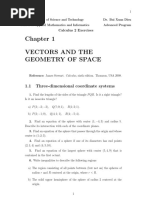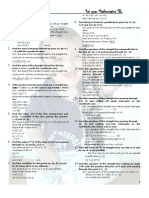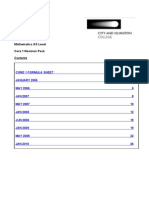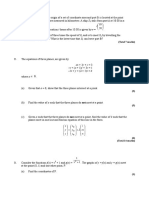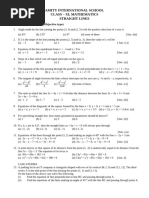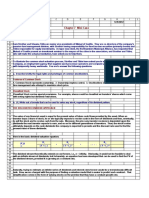MATH132 - S1, 2013 Mathematics IA (Advanced) : Week 13 Tutorial Exercises
Uploaded by
Rahil VermaMATH132 - S1, 2013 Mathematics IA (Advanced) : Week 13 Tutorial Exercises
Uploaded by
Rahil VermaMATH132 S1, 2013
Mathematics IA (Advanced)
FACULTY OF SCIENCE
Week 13 tutorial exercises
1. Find a unit vector perpendicular to the plane determined by the points A(0, 2, 1), B (1, 1, 2) and
C (1, 1, 0). (Unit vector means that its norm is one.)
2. Consider the points A(a, 1, 1), B (1, 2, 3) and C (1, 2, 3) in R3 .
a) Find the dot product AB AC in terms of a. Find all the values of a so that the two vectors AB
and AC are perpendicular.
b) Find the coordinates of the cross product AB AC in terms of a. Then find the values of a (if
any) for which the vector AB AC is parallel to (3, 0, 1).
c) Let a = 1, i.e. now we have the point A(1, 1, 1). Find the equation of the plane passing through
A, B and C . Also find the area of the triangle ABC .
3. Suppose that ` is the line in R3 passing through (1, 1, 1) and with direction (2, 1, 2), so that is given by
(x, y, z) = (1, 1, 1) + t (2, 1, 2) for t R.
In addition, let P be the plane given by the equation 2x y + 4z + 10 = 0.
a) Find all the points on ` which are in the plane P .
b) Find the equation of the plane Q passing through (1, 2, 3) perpendicular to the line `.
c) Find the line formed by the intersection of P and Q.
4. Find an equation of the plane through the point (2, 1, 5) that is perpendicular to the planes 4x 2y + 2z = 1
and 3x + 3y 6z = 5. (Its normal will be the cross product of the normals of the two given planes.)
5. Consider the points (1, 2, 3), (0, 2, 4) and (2, 1, 3) in R3 .
a) Find the area of a parallelogram with these points as three of its vertices.
b) Find the perpendicular distance between the point (1, 2, 3) and the line passing through the
points (0, 2, 4) and (2, 1, 3).
6. Consider the points (1, 2, 3), (0, 2, 4) and (2, 1, 3) in R3 .
a) Find a vector perpendicular to the plane containing these points.
b) Find the equation of this plane and its perpendicular distance from the origin.
7. Find the solution of the differential equation
p
p
dx
= t 1 x 2 that satisfies x( ) = 0 .
dt
8. Find the solution of the differential equation
t3
dx
=
that satisfies x(0) = 0 .
dt
(x + 1)2
9. Consider the differential equation
dx 1 + x 2
.
=
dt
1+ t2
tan A + tan B
may be useful.]
1 tan A tan B
(b) In each of the following cases, find a solution of the differential equation which satisfies the given
initial condition:
(a) Find the general solution. [Hint: The formula tan(A + B ) =
(i) x(1) = 1 ,
(ii) x(1) = 2 ,
(iii) x(1) = 1/2 .
(c) Sketch the three solutions on the same set of axes, and indicate the largest interval of the t -axis
where the solution is valid. [The interval must contain the point t = 1 and the solution must be
continuous and differentiable on the interval.]
You might also like
- Fyjc (Science) Terminal October 2024, Mathematics, Qustions BankNo ratings yetFyjc (Science) Terminal October 2024, Mathematics, Qustions Bank4 pages
- Vectors and The Geometry of Space: 1.1 Three-Dimensional Coordinate SystemsNo ratings yetVectors and The Geometry of Space: 1.1 Three-Dimensional Coordinate Systems19 pages
- Vectors and The Geometry of Space: 1.1 Three-Dimensional Coordinate SystemsNo ratings yetVectors and The Geometry of Space: 1.1 Three-Dimensional Coordinate Systems19 pages
- Assignment# 1: MATH-101-Calculus & Analytical GeometryNo ratings yetAssignment# 1: MATH-101-Calculus & Analytical Geometry3 pages
- Giai-tich-2 Bui-xuan-dieu Bt Gt2 Cttt - [Cuuduongthancong.com]No ratings yetGiai-tich-2 Bui-xuan-dieu Bt Gt2 Cttt - [Cuuduongthancong.com]19 pages
- A ( 2, 1,0), B ( 3,1,2), C (1, 1,3), D ( 1, 3, 3) : Total Marks: 40 1) (4) Determine If The 4 Points Are CoplanarNo ratings yetA ( 2, 1,0), B ( 3,1,2), C (1, 1,3), D ( 1, 3, 3) : Total Marks: 40 1) (4) Determine If The 4 Points Are Coplanar2 pages
- Regular Arrear Examination - December 2013 Course: MAT202 - Linear Algebra Time: Three Hours Max - Marks:100 PART - A (10 X 3 30 Marks) Answer ALL QuestionsNo ratings yetRegular Arrear Examination - December 2013 Course: MAT202 - Linear Algebra Time: Three Hours Max - Marks:100 PART - A (10 X 3 30 Marks) Answer ALL Questions2 pages
- Find The Distance From The Point (1, 2, 3) To (A) The Point ( 1, 1, 1)No ratings yetFind The Distance From The Point (1, 2, 3) To (A) The Point ( 1, 1, 1)4 pages
- Sample Booklet (Study Material + Model Paper) For SA-2 Class 1088% (8)Sample Booklet (Study Material + Model Paper) For SA-2 Class 1032 pages
- IIT JEE Maths TopicWisePreviousQuestionsWithAnswersNo ratings yetIIT JEE Maths TopicWisePreviousQuestionsWithAnswers13 pages
- Coordinate Geometry Question Sheet_ Level-1 & 2 (1) (1)No ratings yetCoordinate Geometry Question Sheet_ Level-1 & 2 (1) (1)20 pages
- Analytic Geometry: Graphic Solutions Using Matlab LanguageFrom EverandAnalytic Geometry: Graphic Solutions Using Matlab LanguageNo ratings yet
- Geometry and Locus (Geometry) Mathematics Question BankFrom EverandGeometry and Locus (Geometry) Mathematics Question BankNo ratings yet
- Chapter 11: Forward and Futures Hedging, Spread, and Target StrategiesNo ratings yetChapter 11: Forward and Futures Hedging, Spread, and Target Strategies56 pages
- Chapter 15: Financial Risk Management: Techniques and ApplicationsNo ratings yetChapter 15: Financial Risk Management: Techniques and Applications56 pages
- FINC765NY Portfolio MASTER SYLLABUS Fall 2020 PDFNo ratings yetFINC765NY Portfolio MASTER SYLLABUS Fall 2020 PDF10 pages
- Net Income ($M) 8382 EBIT ($M) 13224 Income Tax Expense ($M) 5016 Return On EquityNo ratings yetNet Income ($M) 8382 EBIT ($M) 13224 Income Tax Expense ($M) 5016 Return On Equity21 pages
- Charter Communications Inc (CHTR US) - GAAP HighlightsNo ratings yetCharter Communications Inc (CHTR US) - GAAP Highlights38 pages




